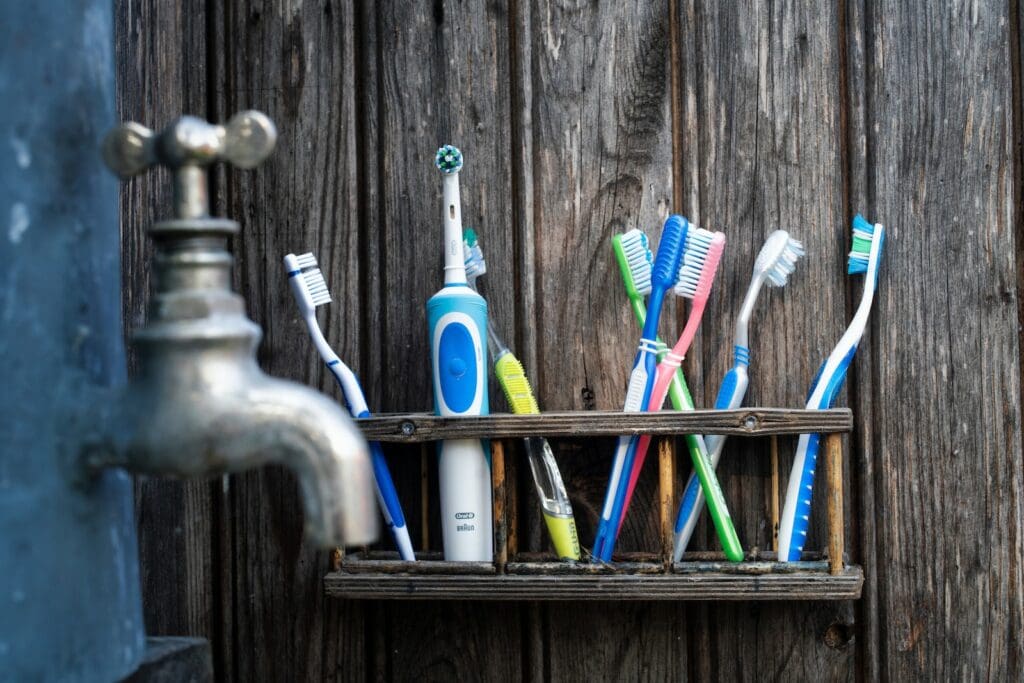
When it comes to oral hygiene, brushing your teeth twice a day is essential. However, it’s not just the frequency of brushing that matters, but also the quality of your toothbrush. Over time, toothbrushes can become worn and frayed, making them less effective at removing plaque and bacteria from your teeth and gums. So how often should you change your toothbrush to ensure optimal oral health?
According to dental professionals and manufacturer guidelines, toothbrushes should be replaced every three to four months. This timeframe ensures that the bristles are still effective at removing plaque and bacteria, and that the toothbrush itself is not harboring harmful germs. However, there are some cases when toothbrushes should be replaced sooner, such as after an illness or if the bristles become frayed before the three-month mark.
It’s important to note that using an old or worn toothbrush can actually do more harm than good. Not only is it less effective at removing plaque and bacteria, but it can also damage your gums and tooth enamel. By regularly replacing your toothbrush every three to four months, you can ensure that you are maintaining optimal oral health and preventing potential dental problems down the line.
Why Changing Your Toothbrush is Important
Regularly changing your toothbrush is an essential part of maintaining good dental hygiene. In this section, we will explore the reasons why changing your toothbrush is important and the impact it has on oral health.
Impact on Oral Hygiene
Using a toothbrush with worn-out bristles can be ineffective in removing plaque and food particles from your teeth, which can lead to the development of gum disease and other oral health issues. The American Dental Association recommends replacing your toothbrush every three to four months or sooner if the bristles become frayed or worn.
Risk of Infection
A toothbrush can harbor bacteria and germs, which can lead to infections and other illnesses. Replacing your toothbrush regularly can help reduce the risk of infection and keep your mouth healthy. In addition, it is important to store your toothbrush in a clean, dry place to prevent the growth of bacteria.
Effect on Gums
Using a toothbrush with worn-out bristles can also have a negative impact on your gums. Brushing too hard with a toothbrush that has frayed bristles can cause damage to the gums, leading to bleeding and inflammation. This can increase the risk of gum disease and gingivitis.
In summary, changing your toothbrush regularly is an important part of maintaining good oral hygiene. It helps prevent the buildup of plaque and bacteria, reduces the risk of infection, and keeps your gums healthy. By replacing your toothbrush every three to four months, you can ensure that your toothbrush is effective in cleaning your teeth and promoting good dental hygiene.
Recommended Frequency of Toothbrush Replacement
When it comes to toothbrush replacement, there are general guidelines that one should follow, as well as special circumstances that may require more frequent replacement. The American Dental Association (ADA) recommends replacing your toothbrush every three to four months, or sooner if the bristles are frayed.
General Guidelines
According to the CDC, the general guideline for toothbrush replacement is every three to four months. This is because, over time, the bristles on a toothbrush become frayed and less effective at removing plaque and bacteria. Additionally, toothbrushes can harbor germs and bacteria, which can lead to illness or infection if not properly cared for.
It is important to note that not all toothbrushes are created equal. Some toothbrushes may need to be replaced more frequently than others, depending on the type of bristles, the quality of the brush, and the frequency of use.
Special Circumstances
There are certain circumstances that may require more frequent toothbrush replacement. For example, if you have been sick, it is recommended that you replace your toothbrush as soon as you start feeling better to avoid re-infecting yourself. Additionally, if you have a weakened immune system or are prone to infections, you may need to replace your toothbrush more frequently to prevent the spread of germs and bacteria.
Older adults may also need to replace their toothbrushes more frequently, as they may have a harder time effectively brushing their teeth and may need a brush with softer bristles.
In summary, the ADA recommends replacing your toothbrush every three to four months, or sooner if the bristles are frayed. However, there are certain circumstances that may require more frequent replacement, such as illness, weakened immune systems, or older age. By following these guidelines, you can help ensure that your toothbrush is effectively removing plaque and bacteria, and reducing your risk of illness and infection.
Signs You Need to Change Your Toothbrush
It is important to replace your toothbrush regularly to maintain good oral hygiene. Here are some signs that indicate you need to change your toothbrush:
Worn Bristles
One of the most obvious signs that you need to change your toothbrush is when the bristles become frayed or worn out. Worn bristles are less effective at cleaning your teeth and can even damage your gums. The American Dental Association (ADA) recommends replacing your toothbrush every three to four months, or sooner if the bristles are visibly worn out.
Bacteria Build-Up
Another sign that you need to change your toothbrush is when it becomes a breeding ground for bacteria. Over time, bacteria can accumulate on the bristles of your toothbrush, which can lead to infections and other oral health problems. If you have been sick, it is especially important to replace your toothbrush to prevent the spread of germs.
To avoid bacteria build-up, it is important to store your toothbrush in a clean, dry place and avoid sharing it with others. You can also rinse your toothbrush with hot water after each use to help kill any bacteria that may be present.
In summary, it is important to replace your toothbrush regularly to maintain good oral hygiene. Signs that you need to change your toothbrush include worn bristles and bacteria build-up. By following these guidelines, you can help keep your teeth and gums healthy.
Types of Toothbrushes and Their Lifespan
When it comes to choosing a toothbrush, there are two main types to choose from: manual toothbrushes and electric toothbrushes. Both types of toothbrushes have their own benefits and drawbacks, and it’s up to the individual to decide which one is best for them.
Manual Toothbrushes
Manual toothbrushes are the traditional type of toothbrush that most people are familiar with. They are typically made of plastic and have bristles made of nylon or other synthetic materials. Manual toothbrushes are widely available and come in a variety of shapes, sizes, and bristle types.
The lifespan of a manual toothbrush depends on how often it is used and how well it is cared for. According to the American Dental Association (ADA), manual toothbrushes should be replaced every three to four months, or sooner if the bristles become frayed or worn. It’s also important to rinse your toothbrush thoroughly after each use and store it in an upright position to allow it to air dry.
Electric Toothbrushes
Electric toothbrushes use technology to provide a more thorough and efficient cleaning than manual toothbrushes. They come in two main types: rechargeable and battery-powered. Rechargeable electric toothbrushes are more expensive but offer more features, such as multiple brushing modes and timers. Battery-powered electric toothbrushes are less expensive but may not offer as many features.
The lifespan of an electric toothbrush depends on the type of toothbrush and how well it is cared for. Rechargeable electric toothbrushes typically last between two and three years, while battery-powered electric toothbrushes may need to be replaced more frequently. It’s important to follow the manufacturer’s instructions for caring for your electric toothbrush, including replacing the brush head every three to four months.
In summary, both manual and electric toothbrushes are effective at cleaning teeth, and the choice between them is largely a matter of personal preference. Regardless of which type of toothbrush you choose, it’s important to replace it regularly and care for it properly to ensure optimal oral health.
Proper Toothbrush Care
To ensure that your toothbrush is effective and safe to use, it is important to take proper care of it. This section will provide some tips on how to clean and store your toothbrush.
Cleaning
Cleaning your toothbrush regularly can help remove any bacteria or debris that may have accumulated on it. Here are some tips on how to clean your toothbrush:
- Rinse your toothbrush thoroughly with water after each use to remove any toothpaste or debris.
- Use a toothbrush sanitizer or soak your toothbrush in mouthwash for a few minutes to disinfect it.
- Use a soft-bristled brush or toothbrush cleaning solution to gently scrub your toothbrush once a week to remove any remaining debris.
Storage
Storing your toothbrush properly can help prevent the growth of bacteria and keep it clean. Here are some tips on how to store your toothbrush:
- Store your toothbrush in an upright position to allow it to air-dry between uses.
- Do not store your toothbrush in a closed container or cover it with a cap, as this can create a moist environment that promotes bacterial growth.
- Keep your toothbrush away from other toothbrushes to prevent cross-contamination.
By following these simple tips, you can ensure that your toothbrush stays clean and effective. Remember to replace your toothbrush every three to four months or sooner if the bristles appear worn or frayed.
The Link Between Oral Hygiene and Overall Health
Maintaining good oral hygiene is essential for overall health. Poor oral hygiene can lead to various health problems, including heart disease, stroke, and other medical conditions. According to the Mayo Clinic, an infection of the inner lining of the heart chambers or valves typically occurs when bacteria or other germs from another part of the body, such as the mouth, spread through the bloodstream and attach to certain areas in the heart. This infection is known as endocarditis and can lead to serious medical conditions.
The Cleveland Clinic explains that oral health is linked to whole-body health, which means that problems with teeth and gums can lead to other health concerns like heart disease, stroke, and more. Periodontist Sasha Ross, DMD, MS, explains the connection between oral health and the rest of the body, including how you can best practice good dental hygiene.
Dental hygiene is essential for overall health. Making sure that you are brushing properly, flossing daily, and keeping up with dental appointments preserves your overall health. Good dental hygiene can help prevent various medical conditions, including heart disease, stroke, and other medical conditions. According to a report published in The New York Times, an international team of experts concluded that there is a significant link between periodontitis and heart attack, stroke, plaque buildup in the arteries, and other medical conditions.
Therefore, it is essential to prioritize oral health alongside overall health. Practicing good oral hygiene and regularly visiting the dentist can help maintain optimal oral health and improve overall well-being. The mouth-body connection is the link between oral health and overall health. It is necessary to take care of your oral health to ensure good overall health.
Environmental Impact of Toothbrush Replacement
While it is important to replace your toothbrush regularly for optimal dental health, it is also essential to consider the environmental impact of toothbrush replacement. Toothbrushes are made of plastic, which is not biodegradable and can take hundreds of years to decompose. As a result, toothbrushes contribute to the growing problem of plastic waste in landfills and oceans.
One way to reduce the environmental impact of toothbrush replacement is to choose toothbrushes made from sustainable materials such as bamboo or biodegradable plastics. These materials are more environmentally friendly than traditional plastic toothbrushes. Some companies even offer toothbrush recycling programs, where used toothbrushes can be sent back to the manufacturer for proper disposal or recycling.
Another way to reduce the environmental impact of toothbrush replacement is to extend the lifespan of your toothbrush. After three months of use, toothbrushes can still be used for cleaning other items such as jewelry or household items. This can help reduce the number of toothbrushes that end up in landfills.
It is also important to properly dispose of toothbrushes when they are no longer usable. Toothbrushes should be thrown away in the regular trash, as they are not recyclable through curbside recycling programs. However, toothbrushes can be recycled through specialized recycling programs or repurposed for other uses.
Overall, while it is important to replace your toothbrush regularly for optimal dental health, it is also essential to consider the environmental impact of toothbrush replacement. By choosing sustainable materials, extending the lifespan of your toothbrush, and properly disposing of toothbrushes, individuals can help reduce the negative impact of toothbrushes on the environment.
Toothbrush Selection and Use for Kids
Selecting the right toothbrush for kids is important to ensure their oral hygiene is maintained. Toothbrushes come in different sizes, shapes, and colors, and it can be overwhelming to choose the right one for your child. Here are some tips to help you select the best toothbrush for your child:
- Size and shape: Choose a toothbrush that fits comfortably in your child’s mouth. A smaller head is better for younger children, while a larger head may be more appropriate for older children. The handle should be easy to grip, and the bristles should be soft to avoid damaging their gums.
- Color and design: Kids are more likely to brush their teeth if they have a toothbrush they like. Let them choose a toothbrush with their favorite color or cartoon character to make brushing more fun.
- Electric vs. Manual: Electric toothbrushes can be more effective at removing plaque, but they are also more expensive. Manual toothbrushes are a good option for younger children who are just learning to brush their teeth.
Once you have selected the right toothbrush, it is important to teach your child how to use it properly. Here are some tips for proper toothbrush use:
- Brush twice a day: Encourage your child to brush their teeth twice a day, in the morning and before bedtime, for at least two minutes each time.
- Use the right technique: Teach your child to brush in circular motions, focusing on each tooth individually. Make sure they brush the front, back, and chewing surfaces of their teeth.
- Replace the toothbrush regularly: Toothbrushes should be replaced every three to four months or sooner if the bristles become frayed. This ensures that the toothbrush is effective at removing plaque and bacteria.
By following these tips, you can ensure that your child’s oral hygiene is maintained and their teeth stay healthy and strong.



